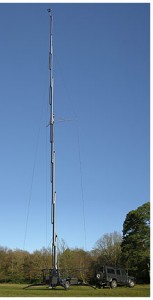The Issue
When professional cameraman, Matthew Gladstone, wanted some shots of sporting events from high angles, he couldn’t find anything to get his camera to the required elevation. So he commissioned a mobile, remotely-controlled mast capable of lifting a full-sized camera to a height of 30m/100ft.
The brief was to design a mast that could be towed by a Land Rover. The rules governing the use of outside broadcast equipment in many sporting venues put tight constraints on the design. For instance, for use on golf courses, the mast must be self-contained and mounted on a single axle. It cannot be towed into position because of damage to the greens, so it has to move under its own power because, at 3.4 tonnes, it is too heavy to manoeuvre manually. It has to have its own power supply because many locations do not have mains electricity, and be silent in operation to avoid disturbing the golfers, which rules out using an on-board generator. Consequently, the unit has to be powered by batteries.
The Solution
The unit incorporates many novel features. The trailer has hydraulic motors driving each wheel independently for manoeuvring it, plus four hydraulic out-riggers for levelling it. It has two hydraulic power packs with a variable speed drive on each pump motor, allowing the speed and direction of each wheel to be controlled separately, for maximum manoeuvrability.
The mast comprises seven sections, the first of which is fixed to the trailer whilst the others run up linear guide rails fixed to the section before it, which extend simultaneously under the action of a winch. The sections are made of carbon fibre, giving them a very high stiffness-to-weight ratio, with a generous spread on the linear bearings, which minimises deflection. With all sections retracted, the mast can be stowed horizontally for transport. When erected, the mast is steadied by four guy ropes, which are paid out by winches as it extends.
Each guy rope is in tension and maintains a constant load on the mast, stabilising it in winds up to 30 knots (Force 7). The ropes for erecting and stabilising the mast are made of Kevlar, which is extremely strong and light, and are pre-stretched to minimise any ‘give’ in the system. The camera sits on a pan-and-tilt mount that is winched up the topmost section of the mast.
 Reaching new heights in the world of film and TV
Reaching new heights in the world of film and TV
Having used a freelance mechanical designer to design the unit he’d named ‘Vortex’, Matthew Gladstone called on my expertise to make it work. An early decision about Vortex – to use batteries – had a major influence on the design of the electrical and control system, and the choice of equipment. The first challenge was to maintain the correct tension in the guy ropes as the mast extended. Tests showed it wasn’t sufficient simply to maintain a constant torque on the motors driving the winches because this did not stop the mast swaying in the wind. The only way to stabilise the mast was to maintain a constant tension in the guy ropes by maintaining their lengths constant relative to the height of the mast. Consequently, it is necessary to control the rate at which the guy ropes are paid out relative to the speed at which the mast extends, with a following error of no more than +/-4mm over 30m. To do this, operation of all five winches has to be synchronised by an intelligent motion controller. The winch driving the camera mount on the topmost section of the mast provides a sixth axis of motion, which can be synchronised with the other five axes. The need to control the motion precisely dictated the use of geared servomotors to drive the winches; the use of batteries dictated that the system be as energy efficient as possible.
The servo amplifiers chosen for driving the motors can be powered by batteries, and feature dynamic braking, allowing any braking energy to be injected back into the supply. So the energy generated by the guy rope winch motors as the mast extends is injected back into the batteries at the same time as the winch motor raising the mast absorbs energy, and vice versa. Another useful feature of the servo amplifiers is that they can be reconfigured as open-loop, flux vector, variable speed drives for AC motors; because the trailer is never moved whilst the mast is being raised or lowered, two of the amplifiers are also used for driving the pump motors on the hydraulic power packs. The batteries hold enough charge for a day’s filming but, for good measure, the system also includes a battery charger for when they start to tire.
Vortex is controlled by an assistant, working under the cameraman’s direction, using a hand-held pendant with joysticks for progressive control of all movements. It also incorporates a number of load cells for measuring critical forces on the structure. Consequently, the motion controller has to handle a wide range of analogue and digital signals. The different functions are interlocked in logic, to ensure safe operation at all times.
Vortex’s first outing at the Cheltenham Gold Cup Festival, in March 2008, tested its form. It was so windy that racing had to be abandoned on one of the days, but Vortex* romped home with flying colours!
For information about Vortex, contact Matthew Gladstone via his website: www.cammotion.co.uk
The value to Matthew Gladstone of my contribution:
- Acting as technical lead on the project
- Interpreting his requirements to maximum effect
- Coming up with innovative and novel solutions to difficult problems
- Charging a fair price for designing, supplying and commissioning the electrical and control system
- Providing on-going support until the project had been successfully completed




Follow Tim!